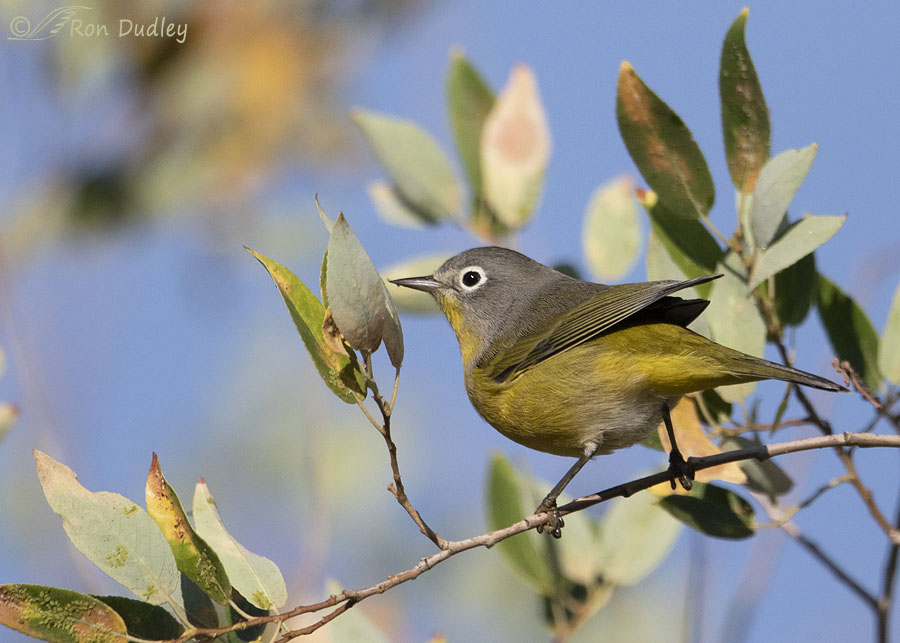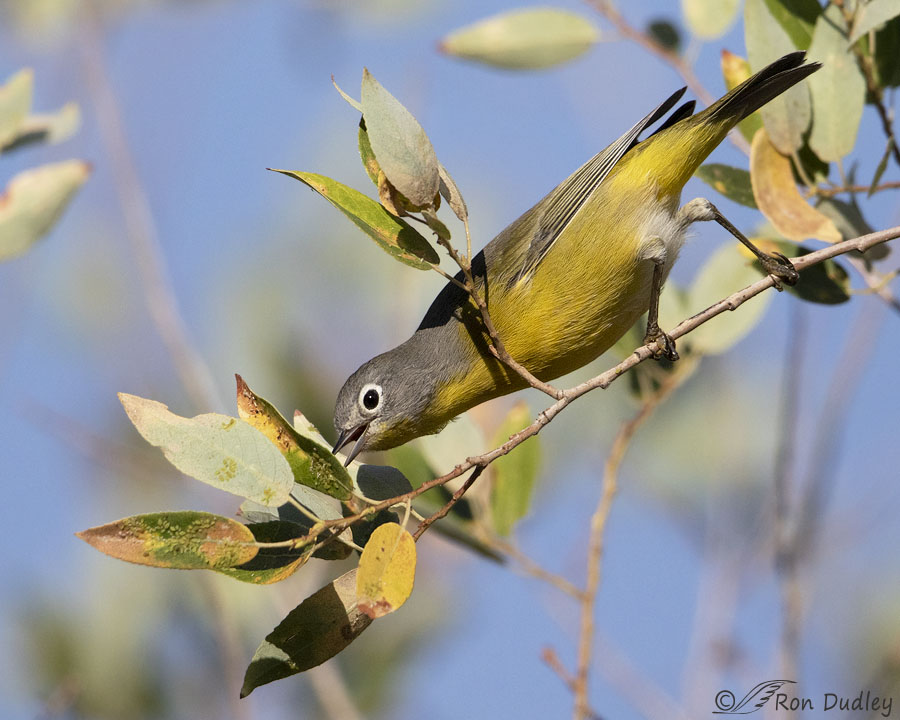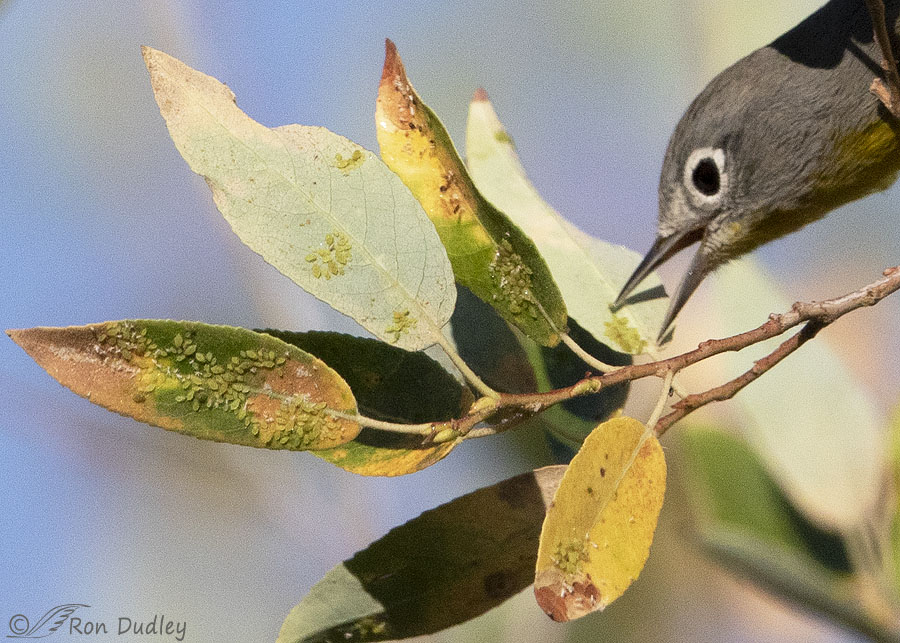Note: I have serious mud on my face. This is a male Nashville Warbler, not a female MacGillivray’s Warbler. Sheesh…
A fun surprise in the Wasatch Mountains yesterday morning.
Until this year I’d never managed to get any decent photos of MacGillivray’s Warblers and even sightings of them had been rare. Their remote distribution and elusive behavior make them a notoriously difficult quarry for both birders and bird photographers but this summer I’ve had just a little more luck with them.

Yesterday morning this female made a brief appearance in a willow as she was foraging for insects. For a few moments she poked around in the cluster of leaves directly in front of her face. As she was doing so she spotted hordes of juicy aphids on the terminal leaf cluster at the end of the twig she was using as a perch.
Perhaps she thought the twig would be too spindly to support her weight if she moved to the end of it in order to get at the aphids so instead she…

performed a big stretch to get at them which put less weight on the end of the twig.
I took many photos of her as she was harvesting the numerous aphids but in many of them part of her face was obscured or I didn’t have any light in her eye. This was the best shot I managed to get and I like it a lot.

As we can see in this huge crop of a different photo she had more than enough aphids to choose from.
The leaves aren’t looking so good but that’s to be expected with so many aphids sucking their sap. In addition to weakening plants by sucking sap aphids act as vectors for plant viruses and disease and disfigure plants with deposits of honeydew that results in the growth of sooty molds.
But this time of year aphids are an almost limitless source of food for birds so that at least is a good thing.
Ron
PS – Even though I really screwed up my initial ID of this bird I’m even more excited that it’s a Nashville Warbler instead of a MacGillivray’s Warbler because that makes this bird a new life bird for me photographically. In Utah the Nashville Warbler is listed as an ‘uncommon migrant’.
I botched the ID because I didn’t notice that this bird has a complete eye ring instead of the broken eye ring of the MacGillivray’s Warbler. Pay attention Bub!


People pay lots of money to have mud on their faces, so silver lining. 😉
Whatever the bird’s name is, it is a beauty!
My mud was cheap, Marty. And nasty…
Hopefully, there were no worms, although you do tend to be an “early bird. ” 🙂
Ron – I just thought I would make another comment. Nashville and MacGillivray’w Warblers are easily confused, especially as people are learning to ID their birds. By making this mistake and pointing out the complete, not broken eyering of the Nashville, you’ve called attention to this feature and provided a good aid, along with a great photo, to help others to distinguish these two species when they see them in the future. Mistakes can always be a helpful tool in learning.
Good point, Dan.
Either would be new to me, and misidentifying would be a given. She is an absolute beauty under any name.
My trivial mind has honed in on the aphid clearance. My garden could feed a colony and only yesterday I noticed a) the very first shoots on roses and b) that the aphids had seen them first.
EC, it doesn’t take aphids long to find roses, does it. Some years my roses are so thick with them I’m surprised they survive.
Happy early springtime in OZ!
Ron,
At least your identification skills surpass mine: LBJ, Sparrow, Cool Bird, Some kind of finch, etc.
Love your posts. I need to get out more but I have enjoyed the Burrowing Owls at AI. As you have said before, some of them (and other birds) “are way too close to the road.”
Honestly, I used to be the guy you referred to several posts ago that would get out of the car with tripod in hand. Usually the bird would simply leave (smart bird). I never chased it around the Island though. Your blog has taught me remotely (before it was mandatory) to use the Jeep as a “blind.” Also, your blog has pointed out the relatively nice variety of birds we have in Utah. (I have lived here almost my whole life and had never been to FB, AI or BRMBR.). I just wish I could find a few more in the canyons; I am mostly unsuccessful in the canyon pursuit. And I would do anything to find “Hummingbird Heaven!”
Keep shooting, posting and educating!
Stephen
Much of your comment warmed my heart, Stephen. Thanks for that – you took some of the sting out of my botched ID.
Well, I’ll certainly give you a pass on this — to err is human, after all (and I try to be divine!). 😉 That is one beautiful Nashville, and very happy for you to have snagged a “lifer” even if somewhat by accident.
“That is one beautiful Nashville”
I think so too, Chris and this time of year that surprised me a little. Its plumage looks very fresh so I wonder if it’s a juvenile.
I think the leaf color complements the Warbler quite nicely.
At least you correctly identified the leaves and aphids. Two out of three ain’t bad.😉 Besides, I would be hard put to ID this as any kind of Warbler. Unless, I had a really good photo like this and paged through Sibley.
“Two out of three ain’t bad”
I guess you have a point, Lyle. It could have been worse.
Another amazing capture. Love your photography.
Thank you, Linda.
Beautiful shots of a very hard warbler to take images of!
Thanks, Dick.
I don’t know a single birder (including myself, of course) who has not made a mis-ID, usually a great many over the years. I once called out Western Tanager to my students when I saw it out of the corner of my eye. It magically turned into an American Goldfinch when it landed in a tree and was more clearly visible. I wish it hadn’t happened in front of my students, but we all do it. It’s especially easy to error when you are not well-acquainted with a particular species. Many years ago, a couple of researchers were traveling through our area. They gave a program to our local Audubon group and were excited to play for us a recording of the song of a Townsend’s X Hermit Warbler. Their work was on Hermit’s from elsewhere so they knew well its song. The recording was different from Hermit Warblers or recordings of Townsend’s Warbler. Unfortunately, after the program I, and another faculty member (his research was on bird song) had to tell them that what they actually recorded was not the hybrid warbler but a Townsend’s Warbler singing a dialect heard only in our part of western Oregon. Being unfamiliar with it, an erroneous assumption was made. An easy mistake. The two warblers sound very similar and differences, especially with hybrids and local dialects make it very confusing. This was a very easy and logical mistake to make, but we have all made bigger and much more obvious mistakes, so don’t feel bad. It comes with the territory of being a good birder.
Dan,
Maybe I don’t feel so bad not being able to identify even common birds sometimes. From your post and others it sounds like many of you have professional experience. I best not give up my day job! I am quite good at that.
Stephen
I think I was pretty darn good at my day job too, Stephen. Then I started bird photography as a rank amateur and made oodles of mistakes in both the technical aspects of photography and in bird ID. After 13 years I’m STILL making some of those mistakes!
Ron, again, don’t be so hard on yourself! In falconry, we call those stupid apprentice mistakes and, trust me, they happen way into when you’re called a master. Of course, master only means you’re just beginning to get clear on the questions and each new bird drops you back down to an apprentice again! The good news is those mistakes happen less frequently, but we’re all human. In the time I’ve been following your blog, this is the first time! Sooo, be kind to yourself! You certainly deserve it! 😉
“I wish it hadn’t happened in front of my students”
And I wish mine hadn’t happened on my blog for all the world to see!
In the scheme of things it’s no big deal I guess so I’ll get over it. After all, I don’t have Covid…, at least not yet. 🙂 Bad stuff is relative, isn’t it.
Thanks for the trying to make me feel better, Dan. It helped.
Great photos! This is one of my favorite warblers…maybe because we get quite a few of them here. All those aphids make for a very good meal(s) as he has found! I find the aphids are particularly abundant this year…i’ve been hosing them of my plants for weeks.
Kathy, I get aphids on my roses but their numbers vary dramatically from year to year. I have no idea why.
First of all, you get a bye for the mid-ID! Warblers are tough, often requiring super-human skills. And when all is said and done, you’re merely human and we’re just not perfect, although you hit that mark FAR more often than not. So don’t be so hard on yourself! Yes, I GET that perfectionist thing, but it’s just not always attainable.
How exciting to catch a lifer and what a little BEAUTY! Chances are none that I’d ever see one–slim is not available. I love the stretch, but that makes me think about how many aphids it takes to fill up one little warbler. WOW! Eating like a bird, indeed!
“Eating like a bird, indeed.”
Laura, I always made it a point to explain to my students why that was such a ridiculously inaccurate phrase in the context of how it’s meant. .
That is an excellent shot and they are handsome birds. You don’t realize how many aphids there are on plants until you see a close-up shot like this. Twice a day we have a flock of Bushtits that swarm into a large Rose of Sharon we have in the backyard to eat the aphids. And they are usually there for at least ten minutes trying to get their fill.
Those bushtits sound like a great opportunity for photography, Everett!
What a handsome little guy. I love that big stretch!
Thanks, Arwen.
That is exciting, seeing a new bird. It’s a beauty. Aphid delight! I love the first shot.
Exciting indeed, Jean. But embarrassing too. I’ll pay that price for a Nashville Warbler.
I can’t keep track of the variety of warblers, but i’ll add this to my education, along with the word “aphids”. Looks like a cross of Pine warbler & White-eyed Vireo. Thanks for the share.
Ha, apparently I can’t keep track of them either, Elmer.
Beautiful Warbler no matter what kind – glad the mis-identification worked out even with a better ID for you!
Yard is already “Labor Day Quiet” bird wise – wonder what THAT portends….. 🙁 Smoke bad yesterday – wind and a bit of rain cleared it out some last evening. UGH!
Thanks, Judy. I HATE making such public mistakes… 🙂